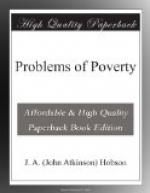Sec. 4. Trade Union Methods of limiting Competition.—So far we have regarded the value of combination as dependent on the ability of workers to combine. There is another side which cannot be neglected. Two societies of workmen equally strong in the moral qualities of successful union may differ widely in the influence they can exert to secure and improve their position. We saw that the real value of organization to a body of workmen lay in the power it gave them to make it inconvenient for an employer to dispense with their services in favour of outsiders. Now the degree of this inconvenience will obviously depend in great measure upon the number of outsiders qualified by strength and skill to take their place without delay. The whole force of Unionism hangs on “the unemployed.” The strongest and most effective Unions are in trades where there are the smallest number of unemployed competitors; the weakest Unions are in trades which are beset by crowds of outsiders able and willing to undertake the work, and if necessary to underbid those who are employed.
Close attention to the composition and working of our Trade Unions discloses the fact that their chief object is to limit the competition for work in their respective trades. Since their methods are sometimes indirect, this is sometimes denied, but the following statement of Trade Union methods makes it clear. The minimum or standard rate of wages plays a prominent part in Unionism. It is arbitrarily fixed by the Union, which in its estimate takes into account, [Greek: a]. prices paid for articles produced; [Greek: b]. a reasonable standard of comfort; [Greek: g]. and remuneration for time spent in acquiring necessary skill.[30] This is an estimate, it must be remembered, of a “fair wage,” based upon calculations as to what is just and reasonable, and does not necessarily correspond to the economic wage obtainable in a neighbourhood by the free competition of labour and capital. Now this standard wage, which may or may not be the wage actually paid, plays a very prominent part in Unionism. The point of importance here is its bearing on the admission of new members. The candidate for membership has, as his principal qualification, to show that he is capable of earning the standard rate of wages. It is evident, however, that the




